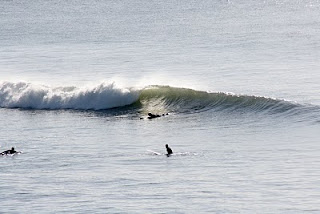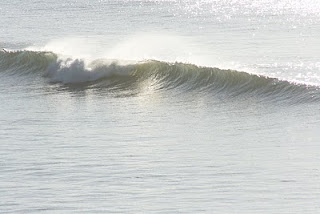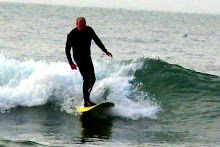
| Bolinas | Patch |
| 10:40 am to 12:15 am | 3' to 4', sets to 6' |
| High dropping tide | No wind |
| Bright sunny day, heat wave | Good session |
“Hey Loren, where did you park? Berkeley?” Jaime the starving artist cartoonist shouted at me as I headed to the ramp to check out the surf. He had just finished his session at the Patch, which he said was ‘ok’, not spectacular.
“No I parked at the lumber yard downtown.”
Not really, I did park far away from the beach, near the 2-Mile Surf Shop. At 9:15 am all the parking slots along Brighton Ave were taken and the cars were spilling down to the Post Office. Reason: Swell N1 – the first Maverick’s size swell of the season. It arrived yesterday and was still pumping today: 11 ft NW swell at 17 seconds, light winds and 57 degree water (that’s as warm as it gets in Northern California) and a high tide. Heat wave weather and a big swell, thus everybody was here. When a big swell hits California, all the other popular surf breaks close out. At Salmon Creek, Dillon Beach and Ocean Beach the waves were enormous and unrideable. Bolinas is one of a few breaks with rideable waves when a Maverick’s size swell rolls in.
Despite the big swell and ideal weather, everyone reported that the waves were merely ‘ok’, not spectacular.
Rob the Bolinas contractor rolled up in his truck, and lowered the window to say hello. He said it was ‘ok’, not great; too much water in the waves due to the high tide and it was crowded.
“You should have seen it yesterday afternoon. It was pristine and there were sixty guys out. Can you believe that for a Tuesday afternoon?”
“No, I can’t believe that.”
“We had beautiful waves that were breaking a little too fast. A few of the really good short boarders got incredible waves. I saw barrel after barrel. Like I said, the really good ones could do it. The rest of us mere mortals got pounded. I got one really good tube ride and that was it. But that one wave made my session. Most of the time I would watch three guys take off on the same wave and all three would get knocked off when the wave closed out. Have a good one.” And off he went.
For the first time this season the high tide was pushing water up the ramp, thus I headed for the overlook about the Groin to check out the surf. Twenty surfers were sitting way out there, at least a quarter mile out to sea. The waves were big, thick and hard to catch. You could see the swells coming for miles; they kept coming, building and didn’t break until they were close to the Groin pole. The surfers were too far out to catch them. One surfer connected in the Channel, he dropped down an overhead wave that quickly broke all around him and buried him in white water. The Channel and Groin did not look inviting.
I moved to check out the Patch. Jeff the Bolinas local just exited the water and walked up the steps to Terrace Road with me. He too had a ‘so-so’ session; mushy waves, too much water, closing out and crowded. But he did get one good ride that made the morning for him.
Twelve surfers were at the Patch, including the Robinsons, Martha and Jim, Marty, David who rides the Becker board and three stand-up surfers. The waves looked mellow, long, slow and fun. I decided to head to the Patch.
I paddled out to the far peak to join David and Marty. The waves were thick and flat on the take-off and difficult to catch. I had to literally let them break on me to get into them.
The three stand-up surfers, who I had never seen before, were having a field day, especially one guy with a baseball cap on a yellow board who paddled on his knees instead of standing up. With the big swells, we could see the waves coming a long ways out there. At first it was deceiving. The swells would peak and often crest as they passed over an outside reef, sandbar, or rock shelf. You would think they were breaking, but no the crest would decline as the waves passed into deeper water and would reform and finally break when they hit the Patch reef. The stand-up guys could catch them when they first crested over the outer reefs, especially the guy with the baseball cap on the yellow board. Being on a longer board with a large planning surface, he could build up considerable board speed, enough to push into the waves when they first peaked. Once up, he would step to the middle of the board and use his paddle to keep in the wave until it jumped again over the Patch reef. He would then swing right and cruise down a head-high wall, cut back left, cruise some more and then swing right again. He did this over and over again. What a beautiful sight to see him one hundred yards further out as he took off on a wave and calmly cruised by us as we paddled over it.
Half way through my session I started to connect. The tide was going out causing the waves to stand up more. Also, I was figuring it out, just like baseball players do. After watching the World Series and having played baseball myself, I know batters adjust to opposing pitchers. Usually after two or three at-bats against the same pitcher, the batters will know what the pitcher is going to throw and will get ready for it. After paddling around, catching a couple of waves, a surfer figures it out: right location, type of wave to look for, steepness of the take-off and number of waves per set. I moved inside and stayed put when waves were cresting on the outside and waited until they reformed and jumped up when they hit the Patch reef.
In the last forty-five minutes of my session I caught five great waves. One set wave was breaking when I turned to go for it. With two strokes I was into it, I dropped down the face of an overhead wave, cut left, climbed to mid-swell, and braced myself as a ton of water slid down from the top of the wave in front of me. I drove under the white water, climbed back up the swell, cruised through a fast section, cut-back into the breaking part of the wave, turned left again, stepped to the middle of the board and hummed through another long section. Later I connected on my longest right wave of the year. Everything came together. I took off, swung right, stayed high in the swell, stalled to let the wave build up, leaned into it to gain speed, stalled again, dropped into an inside section, crouched down and watched the wave unfold in front of me for a hundred yards. When I pulled out I was thirty feet from dry sand. I thought about going in since I was so close to shore. No, that was too much fun, I wanted another one of those.
Novato Pete and Susan who always wears sunglasses in the water came out to join David and I. I watched Susan catch three long rights. Later a set wave approached, I moved to paddle over it as Susan went for it. I thought she would never catch it, but to my surprise she glided into it, swung left and worked it all the way into the shallow part of the reef.
“David, at what time did you come out this morning?”
“A little after eight. I stood around trying to decide whether to go out or not. I finally decided to come out here.” I asked him that at twelve noon as we sat outside waiting for the next set. Shortly after that I went in, changed and went into town to buy a coffee. David was dripping wet, board in hand and just getting to his truck when I returned from town. He was in the water for four and half hours. I could never last that long.
Again it was another warm, beautiful Marin morning, but this one was highlighted by the first Maverick’s size swell of the season.








